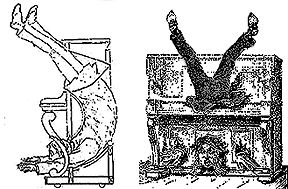


Part I
(Reproduced with permission from Clowns: A Panoramic History by John H. Towsen)



The Hanlon-Lees
By the 1880s, the acrobatic harlequinade had virtually disappeared from English pantomime, and in the circus the fashion increasingly called for talking clowns. In this same period, however, the rich tradition of knockabout comedy and scenic trickwork reached new levels of artistry in the productions of the Hanlon-Lees pantomime troupe. The Hanlon-Lees and their many imitators (the Leopolds, the Craggs, the Pinauds, Mack and Dixon, and the Byrne Brothers, among others) constituted a second great age of acrobatic comedy, which was to transmit the knockabout tradition directly into vaudeville and silent film comedy. If the Hanlon-Lees have been somewhat ignored by theater historians, it is only because their eclectic style did not conform precisely to the traditional format of English pantomime. Yet, although they eschewed the standard transformation scenes and stock characters, the Hanlon-Lees were closer to the true spirit of the fertile Grimaldi era than were the gaudy scenic extravaganzas that passed for pantomime in the 1880s. Even the British - well accustomed to rough-and-tumble comedy - admitted that in terms of sheer technique the Hanlon-Lees had surpassed anything previously seen.
In France, the Hanlon-Lees created an even greater sensation. D. L. Murray wrote that the Parisians viewed them as "the cynic philosophers of the fin-de-siecle, the unconscious prophets of the crash of civilization." Just as the surrealists, a half-century later saw the essence of their philosophy embodied by a modern troupe of clowns, the Marx Brothers, so the French naturalists, led by Emile Zola heralded the Hanlon-Lees for their "cold-blooded analyses" which "laid bare, with a gesture, a wink, the entire human beast." The realistic detail the naturalists sought to impart to literature had a strange parallel in the exacting caricature and mime play of the Hanlon-Lees. "I wonder," wrote Zola, "what outburst of indignation would greet a work by one of us naturalist novelists if we carried our satire of man in conflict with his passions to such an extreme. We certainly do not go so far in our cold-blooded analyses, yet even now we are often violently attacked. Obviously truth may be shown but not spoken. Let us therefore all make pantomimes."
The Hanlon-Lees were originally the six Hanlon brothers, born in England between 1836 and 1848, but of Irish ancestry. Before the age of ten, the older brothers became students of the well known acrobat, "Professor" John Lees, under whose tutelage they became extraordinary tumblers. Lees especially delighted in foot juggling with the Hanlons - an act known as "risley" after "Professor" Richard Risley Carlisle (1814-1874), the American acrobat who popularized the act. The troupe made their debut at London's Theatre Royal Adelphi in December 1846, billed as "entortilationists." (In French, entortillage means "twisting, coiling.") Lees was given full charge of George, William, and Alfred Hanlon in 1848, embarking with them on a worldwide tour. In 1855, while in Panama, Lees died suddenly of yellow fever. The Hanlons returned to England and, with their brothers Thomas, Edward, and Frederick, formed a new troupe, calling themselves the Hanlon-Lees. Their American debut was in 1858 with a circus playing at New York City's Niblo's Gardens. They spent much of the 1860s performing in Europe and the United States, appropriately billed as the "Hanlon-Lees Transatlantic Combination."
Having grown up performing as human projectiles in Professor Lees's risley act, the Hanlon brothers naturally excelled at throwing themselves about. William Hanlon, for example, performed back somersaults from the shoulders of one brother to those of another. They likewise perfected a series of daring pyramids. When Jules Léotard (1838-1870) introduced the flying trapeze to Paris in 1859, the Hanlons dispatched one of their number to France to take notes on this brand-new circus act. Soon the HanIons were plastering New York City with the word zampillaërostation, their own term for the flying trapeze act they premiered at the Academy of Music (in Italian, zampillare means "to gush, to spring forth"). In their "great act," as it was billed, "Little Bob," a boy acrobat, was thrown from one brother to another on trapezes high above the auditorium. As he soared through the air, Little Bob "threw somersaults and turned completely around," as in a modern flying return act. For obvious safety reasons, the Hanlons designed a net to hang under the trapezes - perhaps the first time this now-common device had ever been used.
One of their most popular feats was the "perilous ladder," in which one brother balanced a long ladder while the others performed acrobatic stunts at the top. It was while performing this feat in Cincinnati in 1865 that the eldest brother, Thomas, fell and suffered serious head injuries. Bone splinters in his brain destroyed his sanity, and on April 5, 1868, he intentionally dived headfirst into an iron stovepipe, smashing his skull and killing himself.

Like Houdini decades later, the Hanlon-Lees recognized the publicity value of exhibiting a few of their daredevil feats in public. In Baltimore, one of the brothers climbed to the top of a towering monument. With thousands of spectators watching them from the street below, they performed dangerous acrobatic stunts on the balcony edge, where the slightest miscalculation would have sent them plummeting to instant death. After finishing their act, they sprinkled the crowd with thousands of fake dollar bills that read, "Go see the Hanlon-Lees!" When they descended - by way of the stairs - a police officer tried to arrest George Hanlon for "attempted suicide."
In Chicago, in 1865, the Hanlon-Lees met the French juggler Henri Agoust, who soon became an important member of their troupe, taking the place of the injured Thomas. In addition to his talents as "the world's greatest juggler," Agoust had experience in ballet, fencing, magic, and pantomime. Until they met Agoust, the Hanlons had been performing daredevil acrobatics with a few comical lazzi thrown in. Agoust persuaded them to turn their full efforts toward acrobatic comedy, and began by rehearsing them in two of Deburau's pantomimes, Harlequin Statue and Harlequin Skeleton.
In 1867, the troupe began performing a short sketch entitled Le Frater de Village, known in English either as The Village Torment or The Village Barber. Columbine's lover, his romantic intentions thwarted by her unwilling parents, shows up at her house dressed as a barber. While Columbine's family passively eats their dinner, her frustrated lover does his best to soften their resistance. Enormous blade in hand, he lathers them from head to foot and then dunks them in a tub of water. When he inadvertently slices off a head or two, he is quite careful to glue them back on. The conclusion is a violent free-for-all, with even the women receiving a fair share of the slaps and kicks. Unusual tactics, perhaps, but Columbine's father finally consents to give her hand in marriage.
With the outbreak of the Franco-Prussian War in 1870, Agoust enlisted in the French army and did not rejoin the Hanlons until 1876. In 1878, the troupe began to devote itself to the task of developing pantomimes around its unrivaled acrobatic talents. "We finally decided to unite them, to let one complement the other," recounted George Hanlon. "We envisioned a series of works in which fantasy, agility, and true realism would play equal roles." They even met regularly to discuss their dreams, for in them they found powerful material for their pantomimes. With William arranging the scenarios and Alfred the music, the next two years were spent in Paris creating and performing several incredibly macabre pantomimes.
In Pierrot the Terrible, for example, the sheep's heads and calves' tongues in the butcher shop come alive, humans lose their limbs on the butcher's block, and even the statue in the park is arrested for drunkenness. In Apes and Bathers, the Hanlons portrayed monkeys on a day off from the zoo. In The Duel, the deus ex machina takes the form of a bull that literally devours one of the Pierrots. In Soirée in Black Tie, a satire of high society set in a Louis XVI drawing room, a crazed pianist dives into a piano and then comes crashing headfirst out of the frame, just above the pedals. In Pierrot Coffin-Maker, Pierrot earns a living selling upholstered coffins to people before they die. When he kills a man for declining to purchase one of his boxes, Pierrot is haunted by the man's ghost — dressed in the coffin Pierrot had tried to sell him.
Do Mi Sol Do, which ran for thirteen months, used the format of an orchestra rehearsal, but one in which the musicians attacked the conductor (played by Agoust) and everything in sight was smashed to smithereens. Violent assaults and multiple explosions could not faze this conductor, lost in a Wagnerian mist, as he persisted in expressing the music of his soul. The idea for this savage parody, interpreted by the French as a satire of contemporary fashions in music, actually originated in a minstrel show skit depicting the rehearsal of an amateur band; the Hanlons in fact had performed frequently on the same stage with blackface minstrels in the United States, and in the early 1860s were themselves the subject of a minstrel parody.

